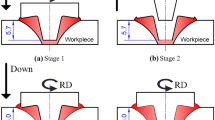Abstract
In this research, the three-dimensional flow of metal in friction stir welding (FSW) has been simulated based on computational fluid dynamics. Conservation equations of mass, momentum, and energy were solved in three dimensions. The interactive force was imposed as boundary conditions on the tool/material boundary in the model. The strain rate- and temperature-dependent non-Newtonian viscosity was adopted for the calculation of metal flow. The distribution of temperature, velocity, and strain rate were simulated based on the above models. The simulated temperature distribution agreed well with the experimental results. The simulation results showed that the velocity on the pin was much higher than that on the shoulder. From the comparison between the simulation results and the experiments results, contours line, corresponding to strain rate = 4 s−1, reflected reasonably well the shape of stir zone, especially at the ground portion.










Similar content being viewed by others
References
W.M. Thomas, E.D. Nicholas, J.C. Needham, M.G. Murch, P. Templesmith, and C.J. Dawes, Friction Stir Butt Welding, G.B. Patent Application No. 9125978.8
K. Colligan, Material flow behavior during friction stir welding of aluminum, Weld. J., 1995, 79(7), p 229
H. Schmidt, T.L. Dickerson, and J.H. Hattel, Material flow in butt friction stir welds in AA2024-T3, Acta Mater., 2006, 54(4), p 1199–1209
A.P. Reynolds, Flow visualization and simulation in FSW, Scripta Mater., 2008, 58(5), p 338–342
Y. Li, L.E. Murr, and J.C. McClure, Flow visualization and residual microstructures associated with the friction-stir welding of 2024 aluminum to 6061 aluminum, Mater. Sci. Eng. A, 2006, 271(1–2), p 213–223
B.C. Liechty and B.W. Webb, The use of plasticine as an analog to explore material flow in friction stir welding, J. Mater. Process. Technol., 2007, 184(1–3), p 240–250
K. Kumar and S.V. Kailas, The role of friction stir welding tool on material flow and weld formation, Mater. Sci. Eng. A, 2008, 485(1–2), p 367–374
H. Fujii, Y.G. Kim, T. Tsumura et al., Estimation of material flow in stir zone during friction stir welding by distribution measurement of Si particles, Mater. Trans., 2006, 47(1), p 224–232
P.A. Colegrove and H.R. Shercliff, 3-Dimensional CFD modelling of flow round a threaded friction stir welding tool profile, J. Mater. Process. Technol., 2005, 169(2), p 320–327
H. Atharifar, D. Lin, and R. Kovacevic, Numerical and experimental investigations on the loads carried by the tool during friction stir welding, J. Mater. Eng. Perform., 2009, 18(4), p 339–350
H. Schmidt and J. Hattel, A local model for the thermomechanical conditions in friction stir welding, Model. Simul. Mater. Sci. Eng., 2005, 13(1), p 77–93
R. Nandan, G.G. Roy, T.J. Lienert et al., Three-dimensional heat and material flow during friction stir welding of mild steel, Acta Mater., 2007, 55(3), p 883–895
M. Grujicic, G. Arakere, C.F. Yen et al., Computational investigation of hardness evolution during friction-stir welding of AA5083 and AA2139 aluminum alloys, J. Mater. Eng. Perform., 2011, 20(7), p 1097–1108
M.Z.H. Khandkar, A.J. Khan, A.P. Reynolds, and M.A. Sutton, Predicting residual thermal stresses in friction stir welded metals, J. Mater. Process. Technol., 2006, 174(1–3), p 195–203
Q.Y. Shi, T. Dickerson, H.R. Shercliff, Thermo-Mechanical FEM Modelling of Friction Stir Welding of Al-2024 Including Tool Loads, Proceedings of 4th International Symposium on Friction Stir Welding, USA, 2003
O.C. Zienkiewicz and I.C. Cormeau, Visco-plasticity-plasticity and creep in elastic solids-a unified numerical solution approach, Int. J. Numer. Meth. Eng., 1974, 8(4), p 821–845
T. Sheppard and D.S. Wright, Determination of flow stress. Pt. 1. Constitutive equation for aluminum alloys at elevated temperatures, Metal. Technol., 1979, 6, p 215–223
J.R. Davis, et al., ASM Specialty Handbook: Aluminum and Aluminum Alloys, ASM International, Material Park, OH, 1993, p 685–686
R. Nandan, T. DebRoy, and H.K.D.H. Bhadeshia, Recent advances in friction-stir welding—process, weldment structure and properties, Prog. Mater. Sci., 2008, 53, p 980–1023
P.F. Mendez, K.E. Tello, and T.J. Lienert, Scaling of coupled heat transfer and plastic deformation around the pin in friction stir welding, Acta Mater., 2010, 58, p 6012–6026
Y. Morisada, H. Fujii, Y. Kawahito et al., Three-dimensional visualization of material flow during friction stir welding by two pairs of x-ray transmission systems, Scripta Mater., 2011, 65(12), p 1085–1088
Acknowledgments
The work was financially supported by MHI, Japan under the project of “Development of numerical simulation during friction stir welding.” The research work was also supported by the National Science and Technology Major Project of the Ministry of Science and Technology of China under the Project No. 2012ZX04012-011.
Author information
Authors and Affiliations
Corresponding author
Rights and permissions
About this article
Cite this article
Chen, G.Q., Shi, Q.Y., Fujiya, Y. et al. Simulation of Metal Flow During Friction Stir Welding Based on the Model of Interactive Force Between Tool and Material. J. of Materi Eng and Perform 23, 1321–1328 (2014). https://doi.org/10.1007/s11665-014-0886-y
Received:
Revised:
Published:
Issue Date:
DOI: https://doi.org/10.1007/s11665-014-0886-y




